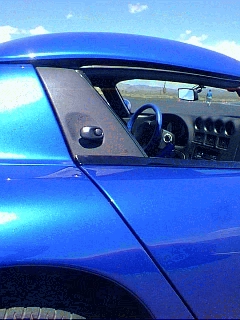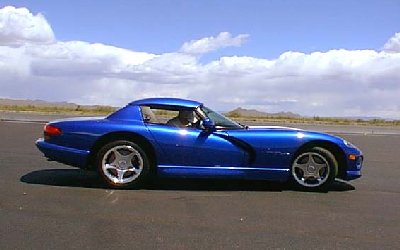More is better. It's the simple credo of the sports car aficionado. So
any time you can add 8 percent more power, it's cause for celebration. But
when you're talking about the Dodge Viper roadster, that adds up to some
even more impressive numbers. In this case: 450. As in horsepower. As in
neck-snapping acceleration.
The Viper has never been short of
power. Even when it first rolled out of the factory in 1992, there was
enough torque to smoke rubber in three gears. But the difference in
performance with the '97 roadster (above, in front of the '97 GTS coupe)
is nonetheless obvious, as we learned on a tight little handling course
set up on the tar lake at Chrysler's Arizona Proving Grounds. But more on
that in a moment.
The Viper roadster is just coming back into
production after a year's hiatus. It was put on hold so Chrysler could
move production to a new plant and then launch the all-new Viper GTS
coupe. You hear a lot about continuous improvement from Detroit these
days, and both the roadster and the coupe have gone through some changes.
But they still live up to the program's original, simple and
straightforward philosophy, stresses John Fernandez, the new head of the
Viper program who has earned a long list of credits in the racing and
performance field. Unlike most Japanese sports cars—and even the new
Corvette—the Viper is a paean to the past, to the era when a sports car
meant performance and handling. Forget the bells and whistles. (Well, most
of them, anyway.) We're talking Shelby Cobra as a role model.
No to
side pipes, yes to real windows
It'll take a close look to see the
differences between the '96 and '97 roadsters. Perhaps the most apparent
cue is the lack of the massive, chromed exhaust pipes that used to curve
out of the rocker panels, just behind the roadster's doors. The side pipes
were a great look, but they wouldn't pass the increasingly tight noise
requirements more and more states have been passing, according to
Fernandez. And side exhaust pipes made it difficult to mount—and
protect—the sensors needed for the new federal OBD2 onboard diagnostics
system. So Chrysler borrowed the rear exhaust system developed for the
GTS. Indeed, virtually every change on this year's roadster has been
lifted from the coupe.

A closer inspection will reveal the '97 roadster has
real, electrically operated windows. There's little to miss about the
removable plastic curtains that came with the original Viper. True, they
were more like what you'd find on past classics, but they were awkward,
clumsy, leaked like the Titanic and, when not in use, took up too much of
the Viper's too-little trunk space.
Viper fans know that there's
never been an exterior door handle, and the '97 stays true to form. With
its hardtop, the coupe needed a creative alternative—and it came in the
form of an electric pushbutton system mounted on the window pillar
(above). With power windows, you can now lock your roadster. And that
means you get the pushbutton door handles, too. The system does pose a
problem if the battery fails. With the GTS, you can unlock the rear hatch
with a conventional key and reach over to grab an emergency manual
release. With the roadster, there is no hatch, but the tiny rear window is
now hinged and locked (below). So, in the unlikely event the button
releases fail, you simply unlock the back window and reach for a manual
release.
> The '97 roadster also adopts the novel,
adjustable pedal system developed for the GTS. With the twirl of a knob,
you can move the clutch, brake and accelerator pedals forward or back by
up to 4 inches. It may sound like a gimmick, but it's not. It made it
amazingly easy for this 6-foot-2-inch driver to optimize seating without
awkwardly compromising either leg's position to steering wheel grip. For
some folks, it's the only way to drive a roadster, as one especially short
woman reporter discovered during the original Viper preview a few years
back. She couldn't even reach the pedals until a thoughtful PR person
propped a couple of large pillows behind her back.

For '97, the
roadster's hardtop (above) and air-conditioning systems now come standard,
though that bumps the base price of the open-top Viper up to $66,000, the
same as for the coupe. The move actually won't affect many people since
the reality was that 95 percent of the roadsters rolling out of the plant
were being sold with tops and AC, says Herb Helbig, the Viper's top
engineer. But if you're an absolutist purist, you can still delete one or
the other, saving $3,700 for both.
Upgraded engine, steering
control
There's yet another change for '97 that was also influenced
by the GTS. The reborn roadster gets the coupe's upgraded—and almost
completely redesigned—version of the 8-liter Viper V-10. The upgraded
engine is stronger and lighter, it has better cooling and, for Viper fans,
the best news is that it bumps the pony count from 415 to 450. Unless
you're using a radar gun, you may not really notice the difference
stomping the accelerator when the light turns green. The originally Viper
had enough neck-snapping power to keep your chiropractor in business. But
get out on the tight-and-twisties, and you'll understand why more really
is better.
The course laid out at the Arizona Proving Grounds was a
maze of sweeping turns and switchbacks. Putting a plain vanilla Chrysler
Concorde through its paces required a degree in patience and caution. But
the Viper held its line as if it were driving on rails. You could squeal
those massive tires in a corner, but you had to work hard to get much more
than a chirp. Driving the '96 roadster first, we found ourselves
constantly working our feet. But with the '97, what used to take a lot of
quick and accurate gear shifts to deliver a good track time could now be
controlled simply through the flexing of your ankle. The added advantage
was the ability to use the accelerator to help control
steering.
It's hard to believe that the Viper roadster is now one
of the oldest cars in the Chrysler lineup. How much longer will it
continue to maintain its appeal? In the fickle sports-car market, that's
hard to determine. But if the '97 is an indication of how the folks at
Team Viper are thinking, they've got plenty of tricks left up their
sleeves. If the Viper philosophy is to keep it simple, the '97 roadster is
simply
better.